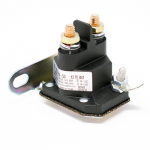The Chairman
Well-Known Member
- Joined
- Aug 9, 2018
- Threads
- 7
- Messages
- 171
My solenoid is not on the starter, but between the battery and the starter. Just follow the positive cable (usually red) to find it on yours.
When there is simply clicking and the battery is good, then it's a bad connection somewhere. I would start by loosening and cleaning all of my grounds. Do the same with the positive wires. Replace any that show corrosion. If that doesn't solve the problem, then it's probably the solenoid. You can check it with a DVOM and jump 12V to the signal side, but that won't tell you how many amps it will pass. I think my replacement was about $15, and I added another ground from the negative terminal of the battery to the base of the solenoid. Be sure to remove ALL wires from the negative side of the battery before you get started. This is a typical lawnmower solenoid. All they are is an electrically operated switch. Power to the bottom tab energizes the solenoid and connects the two lugs on top.
A couple of caveats... there's a battery close by, so avoid sparks. The charging and discharging of many batteries can produce hydrogen: think Hindenburg. Acid in your face and eyes isn't pleasant. Also, those big lugs can carry a lot of amps and that means a lot of heat if you screw up. On my Raptor, there's a fuel tank underneath, so I don't take chances.
When there is simply clicking and the battery is good, then it's a bad connection somewhere. I would start by loosening and cleaning all of my grounds. Do the same with the positive wires. Replace any that show corrosion. If that doesn't solve the problem, then it's probably the solenoid. You can check it with a DVOM and jump 12V to the signal side, but that won't tell you how many amps it will pass. I think my replacement was about $15, and I added another ground from the negative terminal of the battery to the base of the solenoid. Be sure to remove ALL wires from the negative side of the battery before you get started. This is a typical lawnmower solenoid. All they are is an electrically operated switch. Power to the bottom tab energizes the solenoid and connects the two lugs on top.
A couple of caveats... there's a battery close by, so avoid sparks. The charging and discharging of many batteries can produce hydrogen: think Hindenburg. Acid in your face and eyes isn't pleasant. Also, those big lugs can carry a lot of amps and that means a lot of heat if you screw up. On my Raptor, there's a fuel tank underneath, so I don't take chances.

